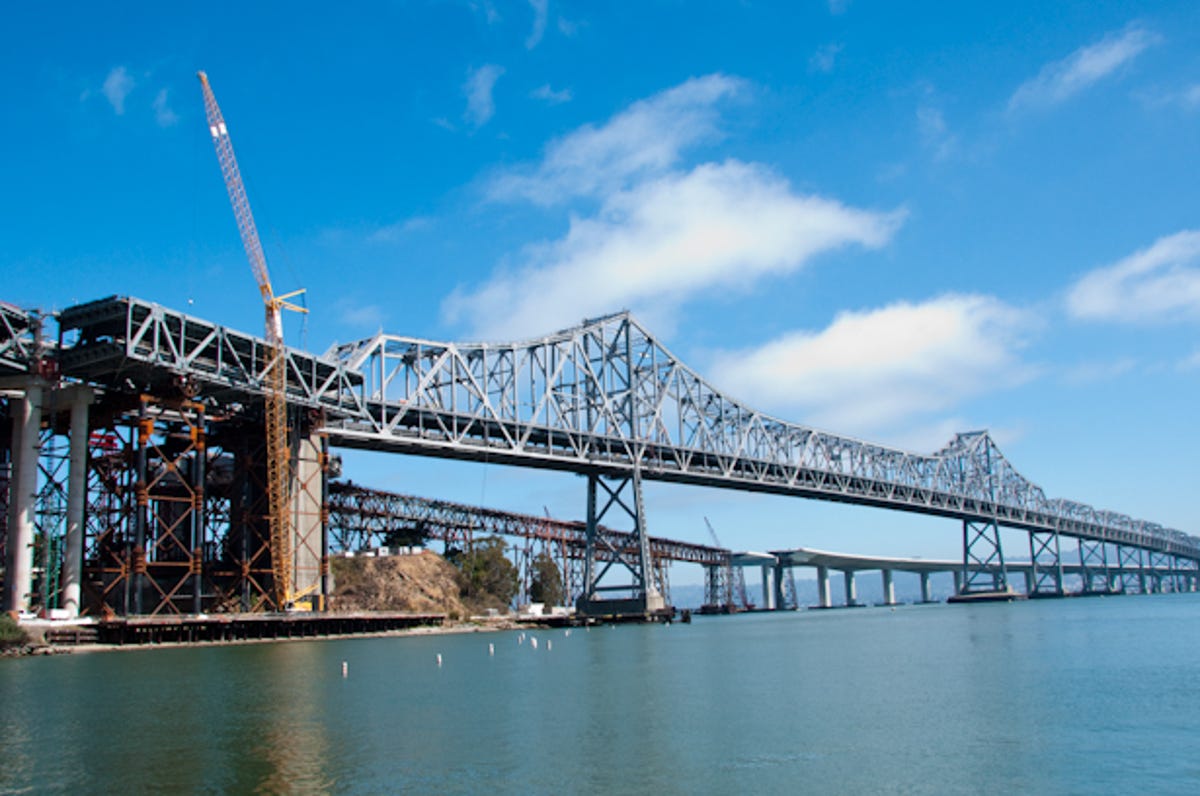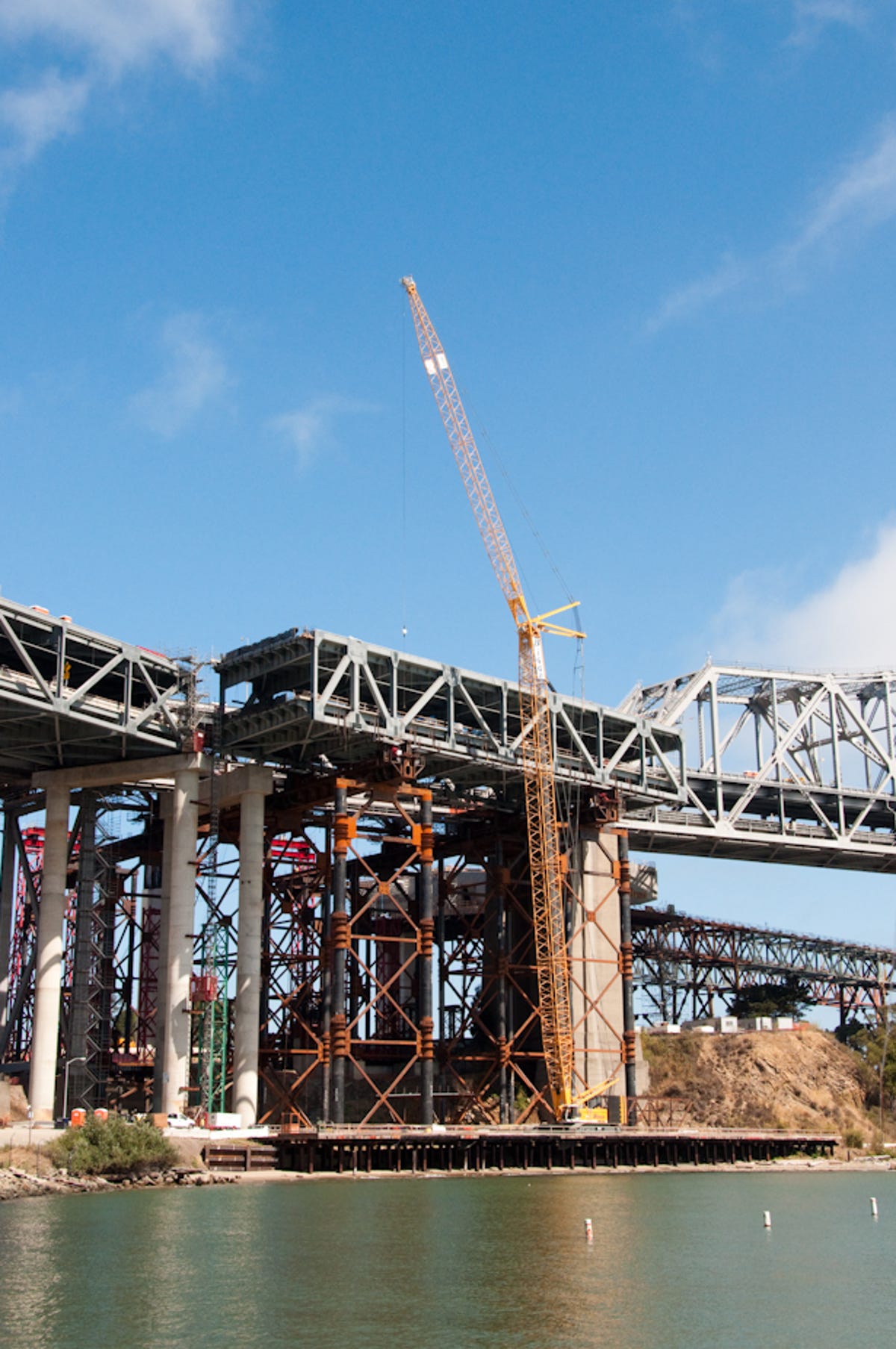Photos: Building a better Bay Bridge
We get an up-close look at the massive construction project going on this weekend to build a sturdier, more modern Bay Bridge, which spans the San Francisco Bay and links San Francisco to Oakland.

Big weekend for a big bridge
The bridge connects San Francisco to Oakland and the rest of the East Bay, making a stopover on Yerba Buena Island, which sits in the middle of the bay. It has seen much change since it opened in the 1930s, much of it involving the eastern span, which connects Yerba Buena Island with Oakland. After a section of the bridge collapsed in the 1989 Loma Prieta earthquake, it was determined that the entire bridge needed seismic upgrades. The San Francisco side simply needed seismic retrofits, but the eastern will be completely replaced. (Shown here is the east span of the bridge, with the current bridge in the foreground and new construction in the background.)
This weekend, the California Department of Transportion, or CalTrans, will pass a huge milestone in that years-long process. Before the new bridge span can be built, a temporary S-curve bypass needs to be put in to allow traffic to flow through while the replacement piece is constructed and moved into place.
To pull off this feat, CalTrans has closed the bridge to all traffic from 8 p.m. Thursday through 5 a.m. Tuesday. Though most people won't have the opportunity to see this impressive work in progress, we were able to ride along on a press tour Friday to see the upgrade in action. Click through for a look at just some of the engineering power it takes to pull off such a massive project.
The calm before the storm
The bridge was closed in record time. The original estimate for closure was two hours. Instead, it took just 21 minutes. Back in 2007, the same type of closure, then for work on a 350-foot detour, took 48 minutes.
The bypass isn't the only work that's being done on the bridge while it's closed. It's also getting a thorough cleaning and re-painting, and will be used by local law enforcement agencies for training that cannot normally be done while the bridge is operational.
Out with the old
Not everything was steel though. Workers had to break apart the huge section of the concrete slab, then get ready to repave the new section once it's in place.
The bypass
The reason for closing the bridge is this bypass. The 300-foot-long section of double decker bridge is angled in a way that can route traffic away from where the new bridge is going. The bypass is expected to be in place until 2013.
After it's installed, the old section of the bridge will be dismantled, and its steel recycled. But before that can happen, both football field-sized slabs of concrete and steel must be slid into place by something called a skid jack.
This one in particular (which looks like two I-beams sitting below the section of the bridge), has been put together by Holland-based Mammoet. Its instantly-identifiable red coloring is almost lost in a sea of support systems, including steel girders that reach hundreds of feet into the air.
The skid jack system uses eight jacks (two on each corner), all of which help to lift up the load, allowing it to be slid with relative ease. Once cut, the slab of the old bridge slides on double-sided Teflon pads that are lubricated in dish washing soap. It moves a little more than a foot at a time, but is much safer than attempting to pull up the entire, aging slab.

Cranes, cranes, cranes
Unlike some of the barge-based cranes that have been used to lift sections of the new bridge more than a hundred feet into the air, cranes like this have been used to hoist both workers and materials. More often than not though, it's used as an OSHA-mandated safety precaution, so that workers have a way of escape if an elevator is out of service and they need to get off the section of the bridge that's being worked on.
Not pictured, and slightly to the left is San Francisco's central Coast Guard station. The U.S. government owns much of the land on Yerba Buena Island, including the area where most of the construction is being done.
Where the old bridge goes
The large concrete pillar seen on the right will be part of the support system that leads the new bridge into the Yerba Buena tunnel.
The old piece is moved
Support system
The section of the existing bridge, which can be seen in the background, will be deconstructed after the detour section is in place. This will make way for the self-anchored suspension span to connect to Yerba Buena Island at an angle that won't interfere with the speed of traffic. In the meantime, this replacement section creates two slight turns that require the speed limit to be dropped from 50 to 40 miles per hour, until the new bridge is operational.
Scaffold city
The section of bridge to the right is being slid into place after the old part is detached and moved to the side. Just below this (though not pictured) is the skid jack, which is what's allowing most of the operation to take place on the same piece of equipment.
The biggest floating crane in the West
This beast of a machine sports 2 full miles of cabling, and can pick up 1,700 tons with relative ease. To put that in perspective, the part that's been moved this weekend is around 3,200 tons--but none of that is dangling from cables.
"Lefty" as it's affectionately referred to by construction workers, was custom-designed for the Bay Bridge job, and costs somewhere in the ballpark of $50 million. Its two parts, both the barge and the crane, were constructed in Oregon and Shanghai, China, respectively, and will be used to hoist up sections of the suspension bridge.
Temporary workers
The new bridge
Unlike the current bridge, the new half does away with the double decker design, and has both directions of traffic moving side-by-side. More importantly, it's capable of withstanding a much higher amount of seismic activity. It also features a protected lane for pedestrians and bikers.
Want to know more about the bridge project and how it's going? You can see video flyovers of what it will look like, and see time lapse video of this weekend's move at its official site.

